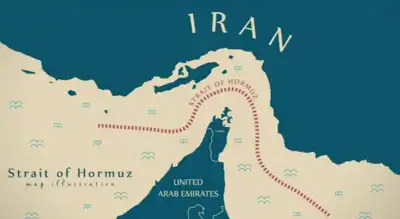Tensions in the Middle East have once again spotlighted the Strait of Hormuz, a critical chokepoint in global energy supply. Amid rising friction between Iran and Israel, fears are mounting over the possibility that Iran could attempt to close the strait, disrupting the flow of oil and gas that powers the world.
The Strait of Hormuz : Why It Matters
The Strait of Hormuz is a narrow, 33-kilometre-wide waterway separating Iran and Oman. It is the world’s most strategically important oil transit chokepoint. In 2024, roughly 21 million barrels of crude oil and refined products passed through the strait every day, accounting for 20 per cent of global oil consumption. Additionally, the strait facilitates:
- 25% of all seaborne oil trade
- 20% of global liquefied natural gas (LNG) exports, primarily from Qatar and the UAE
For the UAE, the strait is indispensable. About 75 per cent of its oil exports go to Asia, particularly China, India, Japan, and South Korea.
Impact Across Regions
If Iran were to move decisively toward closing the Strait of Hormuz, the ripple effects would be felt across the entire Gulf region, threatening energy exports, trade flows, and shipping lanes. However, among regional exporters, the UAE stands out for having taken proactive measures to mitigate such vulnerabilities. The Abu Dhabi Crude Oil Pipeline, which links inland production facilities to the Fujairah terminal, strategically located outside the Strait, has a capacity of 1.8 million barrels per day (b/d). This provides a crucial alternative export route for the UAE, which averaged 3.3 million b/d in oil exports during 2024. While the pipeline does not fully replace Hormuz, it allows the UAE to maintain a substantial portion of its export flows, even in a disruption scenario. In the short term, a sudden surge in oil prices, possibly triggered by panic buying or market speculation, could actually boost national revenues. However, if the disruption proves prolonged, the UAE would face logistical bottlenecks, increased shipping insurance premiums, and rising freight costs, especially in maintaining its robust energy trade with Asian markets.Other Gulf countries would also be affected:
- Saudi Arabia sends 6 million b/d through the strait, but can reroute up to 5 million b/d via its East-West Pipeline.
- Qatar, a key LNG exporter, could see major shipping delays.
- Kuwait and Iraq, with fewer rerouting options, would be more vulnerable to temporary export disruptions.
United States
The U.S. imports less than 5% of its oil through the Strait of Hormuz, limiting direct supply risks. However, price volatility would still hit consumers hard. According to Goldman Sachs, a prolonged closure could send oil prices to $100–$120 per barrel, or even $150 in worst-case scenarios. In such cases, U.S. gas prices could exceed $4 per gallon, fueling inflation and stretching household budgets.
Europe
Europe sources about 15% of its gas from Qatar, making the strait crucial to its energy supply. A blockade would worsen Europe’s energy crunch, already under pressure from reduced Russian gas supplies. The result would be:
- Increased prices for homes and factories
- Rising inflation
- Slowing economic growth
Asia
Asia has the most to lose:
- 75% of oil passing through the strait is bound for Asia
- China receives 45% of its crude via the strait and may need to draw on emergency reserves
- India, also deeply reliant on Gulf oil, would face fuel shortages and economic disruption
- Japan and South Korea would experience supply shocks and higher import costs
Rerouting tankers around the Cape of Good Hope in Africa would significantly increase shipping time and costs, impacting everything from fuel prices to supply chains.
Africa
East African nations such as Kenya and Tanzania, which import fuel via the strait, would see immediate effects. Already in 2024, tanker costs to the region have risen 25–35% due to tensions in both the Red Sea and Strait of Hormuz. A full closure would sharply worsen shortages and drive up living expenses.
Can Iran Actually Do It?
Technically, Iran does possess the military capabilities required to disrupt or potentially block the Strait of Hormuz. These include naval mines, anti-ship missiles, and GPS jamming technologies, tools that have been used or threatened in the past to assert control over maritime routes. During the 1980s Iran–Iraq conflict, often referred to as the “Tanker War,” Iran managed to disrupt shipping in the region, although it never succeeded in fully closing the strait. According to Press TV, Iran’s state-run media outlet, the Iranian parliament has approved a plan to close the Strait of Hormuz. However, the authority to implement such a decision lies with the Supreme National Security Council. Despite the rhetoric and preparations, most experts consider a complete blockade unlikely. One critical reason is that Iran itself relies heavily on the strait to export about 2.5 million barrels per day of oil, including approximately 1.5 million barrels per day to China. Shutting down the passage would significantly damage Iran’s own economy and risk triggering a U.S.-led military response.
The Bigger Picture: Global Economic Fallout
A prolonged closure of the Strait of Hormuz could set off a global energy crisis comparable in scale to the 1973 oil embargo, with ramifications that would extend far beyond the energy sector. Experts warn that oil prices could surge to as high as $150 per barrel, an escalation that would send shockwaves through financial markets, trigger a sharp spike in global inflation, and apply enormous pressure on both developed and emerging economies. The ripple effects would not stop at the fuel pump, supply chains across industries would become strained, with transport, manufacturing, and retail sectors all absorbing the burden of higher input costs and delayed logistics. These elevated costs would inevitably be passed on to consumers worldwide.While Strategic Petroleum Reserves (SPRs) are positioned as a buffer against such shocks, they are not a comprehensive safeguard. Current global reserves include:
- 600 million barrels held by the United States
- 400 million barrels across European nations
- 1.2 billion barrels stored in Asia
However, these reserves offer only short-term relief. Their effectiveness is limited by the rate at which oil can be drawn down, and by accessibility constraints that vary across regions. In the face of a sustained disruption, SPRs would buy time—but not solve the crisis. Energy-hungry economies, particularly in Asia and Europe, would be most vulnerable, and even nations with sizable reserves could find themselves racing against time as markets tighten and geopolitical risks escalate.
Current Situation: June 23, 2025
As of now, the Strait of Hormuz remains open, but tensions are steadily rising and markets are reacting with caution. In recent weeks, Brent crude prices have climbed from $75 to $82 per barrel, reflecting growing anxiety over the security of one of the world’s most vital energy corridors. The uptick in oil prices underscores the market’s sensitivity to geopolitical risks in the region.In direct response to Iran’s threats, the United States has taken concrete steps to reinforce its military presence. The USS Nimitz Carrier Strike Group has been redirected from the South China Sea to the Middle East, a move aimed at strengthening regional deterrence. It has joined the USS Carl Vinson, which is already stationed in the Arabian Sea. Together, these two carrier groups form a significant part of Washington’s broader efforts to enhance maritime security and safeguard the uninterrupted flow of commerce through the strait.The sense of urgency is echoed in the corporate world as well. Shell CEO Wael Sawan warned that “any escalation could disrupt global trade significantly,” capturing the deepening unease across energy markets and highlighting just how interconnected geopolitical tensions and global economic stability have become.This analysis draws on information and reporting from multiple authoritative sources, including the US Energy Information Administration (EIA), OPEC, Reuters, Bloomberg, Platts, Lloyd’s List, CNBC, as well as regional insights via Khaleej Times.






